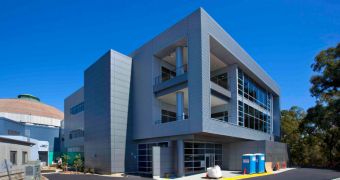Officials announce that the Berkeley Lab campus now houses a new research support facility, which will play a pivotal role in conducting battery research. The work done here could have major implications for the future.
The new building was partially funded with grant money secured from the American Recovery and Reinvestment Act (ARRA 2009).
Lab spaces in the new facility will be mostly dedicated to researching innovative battery technologies, and also metamaterials. The latter are materials that can bend light in weird ways.
The Advanced Light Source (ALS) User Support Building project was estimated to cost $35 million, of which $14.7 million were provided under ARRA 2009.
Builders say that the construction respects the most draconian energy-efficiency norms, and also that it is scheduled to be inaugurated soon, three months ahead of the planned deadline.
“The main purpose of this building is to provide urgently needed staging space for ALS experiments and urgently needed office space for users of the ALS,” explains Joe Harkins, the project's director.
“They can actually roll experiments between the two buildings; there’s a large high-bay staging space and an overhead crane two stories high to manipulate experiments,” he adds.
In addition to modern conference rooms and experiment assembly spaces, the facility also features offices and lab spaces for as many as 80 scientists at any given time.
Previously, experts were housed in World War II-era building. Teams stay at the ALS for days to months to conduct their experiments, and they need to benefit from the best conditions possible.
“Now they’re going in a state-of-the-art building that’s seismically safe and properly cooled and heated,” explains ALS Project and Facility Management Group Leader, Steve Rossi.
The new building is also important because it helps serve the ALS, a facility that allows experts to study the structure of materials on the atomic and molecular level.
It is one of the world’s brightest sources of ultraviolet and soft X-ray beams, and groups from around the world apply for a chance of conducting experiments here.
Now, they can finally do so in a proper manner, experts at the US Department of Energy's (DOE) Lawrence Berkeley National Laboratory (Berkeley Lab) say.

 14 DAY TRIAL //
14 DAY TRIAL //